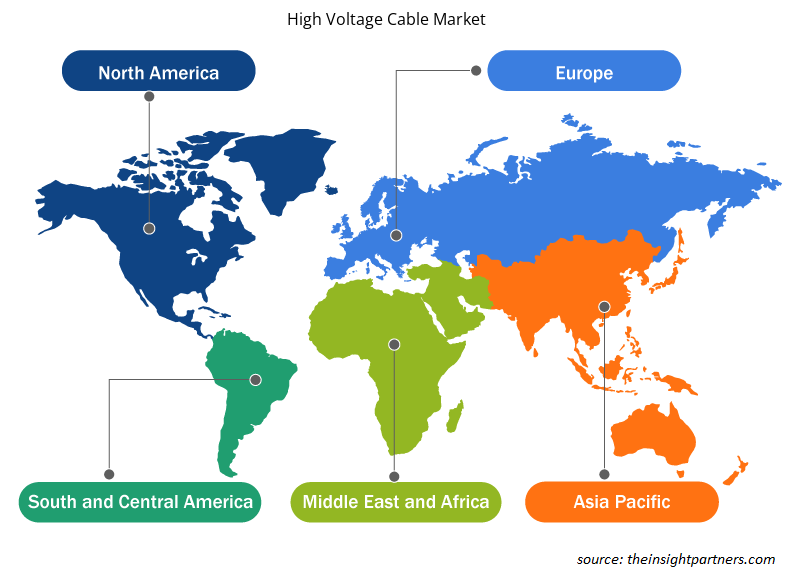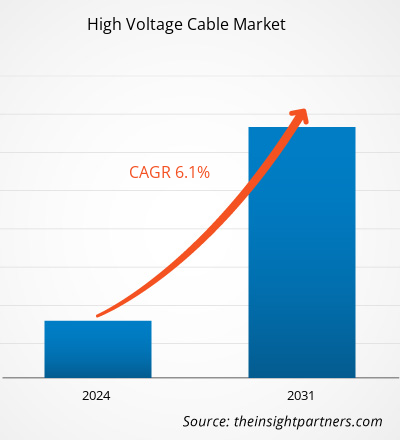Si prevede che la dimensione del mercato dei cavi ad alta tensione raggiungerà i 62,2 miliardi di dollari entro il 2031, rispetto ai 38,7 miliardi di dollari del 2023. Si prevede che il mercato registrerà un CAGR del 6,1% nel 2023-2031. La necessità di sostituire l'infrastruttura di rete obsoleta e l'industrializzazione nelle regioni in via di sviluppo rimarranno probabilmente le principali tendenze del mercato dei cavi ad alta tensione.
Analisi di mercato dei cavi ad alta tensione
Il mercato dei cavi elettrici ad alta tensione si basa in larga misura sulla domanda globale di elettricità. Si prevede che la crescente necessità di elettricità creerà prospettive di crescita redditizie per il mercato. Inoltre, il mercato è guidato dalla sostituzione di infrastrutture di rete e linee di trasmissione obsolete. Inoltre, l'espansione di fonti di energia rinnovabili come l'energia solare ed eolica richiede l'istituzione di nuove reti di servizi e reti di trasmissione e distribuzione, fungendo così da motore di mercato chiave per i cavi ad alta tensione.
Panoramica del mercato dei cavi ad alta tensione
I cavi ad alta tensione sono cavi specializzati utilizzati per trasmettere e distribuire energia ad alta tensione. Questi cavi sono dotati di elementi strutturali, tra cui uno o più conduttori, guaine protettive e isolanti. Ciò che distingue i cavi ad alta tensione dagli altri tipi è la presenza di strati interni aggiuntivi nella guaina isolante, che aiuta a controllare il flusso elettrico attorno al conduttore. Questa caratteristica riduce le perdite di potenza durante le trasmissioni a lungo raggio, rendendo i cavi ad alta tensione più efficienti di altri tipi di cavi di tensione per la trasmissione di energia. Possono essere utilizzati come cavi aerei, cavi interrati nelle industrie e persino come cavi sottomarini per la trasmissione di energia tra stati e paesi.
Personalizza questo report in base alle tue esigenze
Riceverai la personalizzazione gratuita di qualsiasi report, comprese parti di questo report, o analisi a livello nazionale, pacchetto dati Excel, oltre a usufruire di grandi offerte e sconti per start-up e università
-
Scopri le principali tendenze di mercato in questo rapporto.Questo campione GRATUITO includerà analisi di dati che spaziano dalle tendenze di mercato alle stime e alle previsioni.
Driver e opportunità del mercato dei cavi ad alta tensione
Necessità di sostituire l'infrastruttura di rete obsoleta per favorire il mercato
Si prevede che la necessità di sostituire l'infrastruttura di rete obsoleta e di accogliere la rete di smart grid in espansione alimenterà la crescita del mercato globale dei cavi ad alta tensione. Poiché la domanda di energia continua ad aumentare a causa della crescita della popolazione e dell'urbanizzazione, i sistemi di rete obsoleti vengono sostituiti con smart grid avanzate, rendendo necessaria l'istituzione di nuove reti di trasmissione. I cavi ad alta tensione, in grado di trasportare correnti elevate su lunghe distanze, sono la scelta preferita per queste nuove reti, guidando l'espansione prevista del mercato globale nel prossimo futuro.
Adozione delle energie rinnovabili nella produzione di energia: un’opportunità di mercato
Le crescenti preoccupazioni ambientali relative alle emissioni di gas serra e la crescente domanda globale di energia spingono l'adozione crescente di energia rinnovabile nella produzione di energia. Ciò ha spinto i paesi a cercare soluzioni alternative per la produzione di energia, con fonti rinnovabili, in particolare energia eolica e solare, che emergono come le opzioni più favorite. L'aumento dell'impiego di energie rinnovabili richiede l'istituzione di nuove linee di trasmissione, spingendo così il mercato globale. Inoltre, Europa e Nord America hanno piani ambiziosi per ridurre significativamente le emissioni di carbonio nel prossimo futuro, il che dovrebbe migliorare sostanzialmente il mercato delle energie rinnovabili e, di conseguenza, dei cavi ad alta tensione.renewables necessitates the establishment of new transmission lines, thereby propelling the global market. Furthermore, Europe and North America have ambitious plans to significantly reduce carbon emissions in the near future, which is expected to substantially enhance the market for renewables and, consequently, high voltage cables.
Analisi della segmentazione del rapporto di mercato dei cavi ad alta tensione
I segmenti chiave che hanno contribuito alla derivazione dell'analisi di mercato dei cavi ad alta tensione sono la tipologia e l'utente finale.
- In base al tipo, il mercato è segmentato in overhead, underground e submarine. Il segmento overhead ha detenuto una quota di mercato significativa nel 2023.
- In base all'utente finale, il mercato è segmentato in industriale, energia rinnovabile e infrastruttura. Il segmento industriale deteneva una quota sostanziale del mercato nel 2023.
Analisi della quota di mercato dei cavi ad alta tensione per area geografica
L'ambito geografico del rapporto sul mercato dei cavi ad alta tensione è suddiviso principalmente in cinque regioni: Nord America, Asia Pacifico, Europa, Medio Oriente e Africa e Sud America/Sud e Centro America.
Vari fattori, tra cui iniziative governative, produzione di elettricità, progetti di energia rinnovabile e attività industriali, influenzano il mercato dei cavi ad alta tensione in Nord America. I cavi interrati hanno una maggiore penetrazione in Nord America a causa della crescente produzione di elettricità, progetti di energia rinnovabile e iniziative governative a supporto di progetti di energia rinnovabile . L'impennata nella produzione di elettricità ha ulteriormente aumentato l'utilizzo di cavi ad alta tensione. Si prevede che l'aumento delle attività di estrazione di metalli, esplorazione di petrolio e gas e la crescita delle attività di costruzione in Nord America avranno un impatto positivo sulla domanda di cavi ad alta tensione.
Approfondimenti regionali sul mercato dei cavi ad alta tensione
Le tendenze regionali e i fattori che influenzano il mercato dei cavi ad alta tensione durante il periodo di previsione sono stati ampiamente spiegati dagli analisti di Insight Partners. Questa sezione discute anche i segmenti e la geografia del mercato dei cavi ad alta tensione in Nord America, Europa, Asia Pacifico, Medio Oriente e Africa e Sud e Centro America.

- Ottieni i dati specifici regionali per il mercato dei cavi ad alta tensione
Ambito del rapporto sul mercato dei cavi ad alta tensione
| Attributo del report | Dettagli |
|---|---|
| Dimensioni del mercato nel 2023 | 38,7 miliardi di dollari USA |
| Dimensioni del mercato entro il 2031 | 62,2 miliardi di dollari USA |
| CAGR globale (2023-2031) | 6,1% |
| Dati storici | 2021-2022 |
| Periodo di previsione | 2024-2031 |
| Segmenti coperti |
Per tipo
|
| Regioni e Paesi coperti |
America del Nord
|
| Leader di mercato e profili aziendali chiave |
|
Densità degli attori del mercato: comprendere il suo impatto sulle dinamiche aziendali
Il mercato dei cavi ad alta tensione sta crescendo rapidamente, spinto dalla crescente domanda degli utenti finali dovuta a fattori quali l'evoluzione delle preferenze dei consumatori, i progressi tecnologici e una maggiore consapevolezza dei vantaggi del prodotto. Con l'aumento della domanda, le aziende stanno ampliando le loro offerte, innovando per soddisfare le esigenze dei consumatori e capitalizzando sulle tendenze emergenti, il che alimenta ulteriormente la crescita del mercato.
La densità degli operatori di mercato si riferisce alla distribuzione di aziende o società che operano in un particolare mercato o settore. Indica quanti concorrenti (operatori di mercato) sono presenti in un dato spazio di mercato in relazione alle sue dimensioni o al valore di mercato totale.
Le principali aziende che operano nel mercato dei cavi ad alta tensione sono:
- Compagnia dei cavi di Dubai - Ducab
- Società per azioni Furukawa Electric Co., Ltd.
- Nexans SA
- NKT A/S
- Gruppo Prysmian (General Cable Corporation)
- Siemens AG
Disclaimer : le aziende elencate sopra non sono classificate secondo un ordine particolare.

- Ottieni una panoramica dei principali attori del mercato dei cavi ad alta tensione
Notizie e sviluppi recenti sul mercato dei cavi ad alta tensione
Il mercato dei cavi ad alta tensione viene valutato raccogliendo dati qualitativi e quantitativi dopo la ricerca primaria e secondaria, che include importanti pubblicazioni aziendali, dati associativi e database. Di seguito è riportato un elenco degli sviluppi nel mercato:
- NKT si aggiudica contratti per cavi elettrici ad alta tensione da 1,2 miliardi di euro in Germania. L'azienda sta investendo 100 milioni di euro (108,77 milioni di dollari) nel suo stabilimento di Colonia per aumentare gradualmente la capacità entro il 2027. Il produttore di cavi danese NKT si è assicurato un contratto dall'operatore di sistema di trasmissione tedesco (TSO) Amprion per la fornitura di sistemi di cavi elettrici onshore ad alta tensione in corrente alternata (CA) e corrente continua (CC).
(Fonte: NKT A/S, sito web aziendale, 2024)
Copertura e risultati del rapporto sul mercato dei cavi ad alta tensione
Il rapporto "Dimensioni e previsioni del mercato dei cavi ad alta tensione (2021-2031)" fornisce un'analisi dettagliata del mercato che copre le seguenti aree:
- Dimensioni e previsioni del mercato a livello globale, regionale e nazionale per tutti i segmenti di mercato chiave coperti dall'ambito
- Dinamiche di mercato come fattori trainanti, vincoli e opportunità chiave
- Principali tendenze future
- Analisi dettagliata delle cinque forze PEST/Porter e SWOT
- Analisi di mercato globale e regionale che copre le principali tendenze di mercato, i principali attori, le normative e gli sviluppi recenti del mercato
- Analisi del panorama industriale e della concorrenza che copre la concentrazione del mercato, l'analisi della mappa di calore, i principali attori e gli sviluppi recenti
- Profili aziendali dettagliati
- Analisi storica (2 anni), anno base, previsione (7 anni) con CAGR
- Analisi PEST e SWOT
- Valore/volume delle dimensioni del mercato - Globale, Regionale, Nazionale
- Industria e panorama competitivo
- Set di dati Excel
Report recenti
Rapporti correlati
Testimonianze
Motivo dell'acquisto
- Processo decisionale informato
- Comprensione delle dinamiche di mercato
- Analisi competitiva
- Analisi dei clienti
- Previsioni di mercato
- Mitigazione del rischio
- Pianificazione strategica
- Giustificazione degli investimenti
- Identificazione dei mercati emergenti
- Miglioramento delle strategie di marketing
- Aumento dell'efficienza operativa
- Allineamento alle tendenze normative























 Ottieni un campione gratuito per - Mercato dei cavi ad alta tensione
Ottieni un campione gratuito per - Mercato dei cavi ad alta tensione